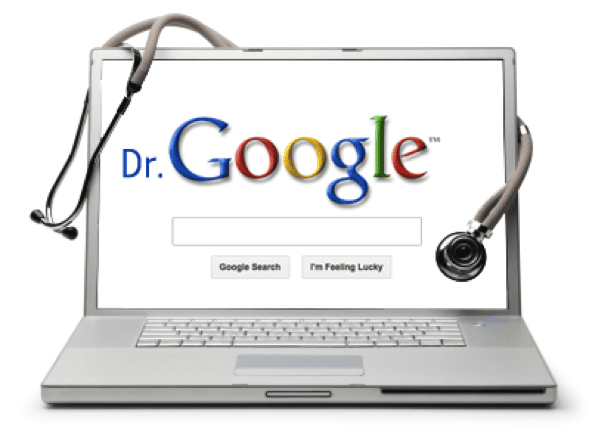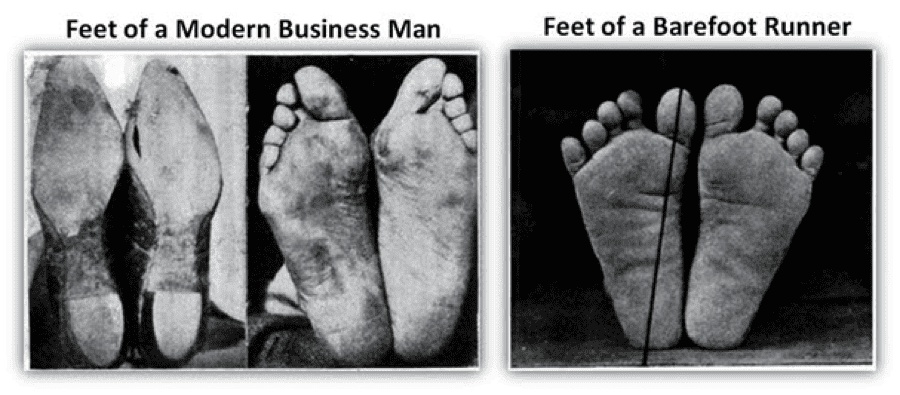If you see me in flip flop sandals, Vibram Five Fingers (VFF), or a barefoot-style shoe at HIMSS14 — please withhold fashion judgment. Since Jan 1, 2014, I have been performing a little “care management” on myself — as ordered by Dr. Google — and have been treating my sports injury by going about barefoot or minimally-shod.
Trusting Dr. Google over my Kaiser podiatrist (recommendation: prescription orthotics), and my Kaiser Sports Medicine Doctor (recommendation: wear a medical boot), was not easy. I was driven by: 1) pure desperation to get back to running, 2) A feeling that the KP system had nothing left to offer me, and 3) a high deductible health plan.
When my healthcare was paid for, and the doctor was all-knowing
I began running as a teenager and within a few years had developed posterior tibial tendinitis (pain and swelling along the inside of the ankle/foot). The podiatrist told me I had flat feet/over-pronated, and that I needed custom orthotics. I blindly trusted him, accepted his diagnosis as fact and was soon running again — pain-free and happy. Pre-Internet, I had no easy way (and no inclination) to really understand the biomechanics of running gait and why the orthotics fixed my symptoms.
A few decades later, I found myself again in a podiatrist’s office. I was suffering from some intermittent pain in my left ankle/foot, and assumed I needed the latest and greatest orthotics.
However, this time around I was no longer that oblivious teenager. I had read the book Born to Run and had also witnessed my husband suffer through various running injuries over the years — injuries that immediately disappeared after he started running in a VFF toe shoe.
I distinctly remember asking the podiatrist if there were any exercises I could do to strengthen my foot, negating the need for orthotics. He told me no, my problem was genetic, and that I would need new $300 prescription orthotics.
Turning to Dr. Google Instead of Dr. Kaiser
After running for several months in the new orthotics the pain came back ten fold. In order to simply walk, I began wearing an ankle brace in addition to the crippling orthotic. After 6 months of not running, I was in as much pain as ever, and was desperate.
During this time period (late last year), a perfect storm of events pushed me towards Dr. Google and healthcare consumerism.
I read The Story of the Human Body, by the “barefoot professor”, Daniel Lieberman of Harvard. Lieberman discusses how the habitual wearing of shoes since childhood deforms and atrophies the human foot — causing a host of problems including flat feet/overpronation. Lieberman also rails against the orthotics industry, describing how orthotics cause the foot to progressively weaken over time until wearers lose the ability to walk barefoot.
At the same time as I was learning about the deleterious effects of shoes on the human foot, I was transitioning into a high deductible Kaiser plan via Covered California. This meant that I would pay dearly for each office visit, and, at that point in time I didn’t feel like spending a dime on KP with regards to this injury. I very much felt (and still do) that I had been duped by both the orthotics maker, and the orthotics-salesman podiatrist.
In short, I had nowhere else to go except to Dr. Google, who was available for free, 24/7, instantly. Over a week I obsessively googled various keyword combinations. I found communities of barefoot runners, flat-foot sufferers, and numerous YouTube videos. Most helpful were the videos and blogs that described in detail, exercises to strengthen arches in flat feet. I also learned the important role of the big-toe in supporting the arch (in nearly all womens’ shoes, the big toe is pushed and squeezed to the side, causing the arch to oftentimes fall).
I formed a hypothesis that this barefoot stuff might cure my foot injury, and so on Jan 1, 2014 started slowly going barefoot as much as I could around the house and doing various foot and lower leg strengthening exercises. I wore VFFs and flip flops outside, and got rid of the ankle brace.
Testing My Barefoot Hypothesis, On a Sample Size of One
Wearing orthotics for so long, I hadn’t realized how weak my feet actually were. In going barefoot, I felt could feel just how feeble each tendon, ligament, and muscle was. At the same time (and despite the ongoing soreness), the post tib pain was subsiding. After 2 days barefoot I could walk without much pain. 7 days barefoot and the pain was gone completely. This was after 6 months of suffering.
Some other outcomes: My foot became noticeably wider, more muscular, and lo and behold I developed an arch in my foot. I have tried to prove these outcomes to myself by trying on a narrow shoe that used to fit but now does not, and by observing my footprint coming out of the pool — before it was a blob, now it looks like a normal footprint.
Disclaimer: yes, I am a sample size of one, this was a non-controlled study. I acknowledge that I too suffer from Optimism bias and Confirmation bias. Also, I don’t yet have enough runs under my belt to know whether or not this barefoot transition will really enable me to run injury-free for a long time. (To date I have been able to run 4 miles at a stretch in the VFFs.) I may get injured tomorrow but for now I am declaring victory.
Analysis: Why Didn’t Kaiser Care if I healed or Not?
Of all healthcare providers, KP as a capitated system should have cared about healing my foot and preventing the need for surgery. However, in this case KP acted completely episodically.
What about population health management outreach? I didn’t receive a single outreach from KP, checking in as to whether the orthotics worked or not. Not even a simple email. (Actually, I am naïve to expect this. KP is a smart actuarial organization and has made the calculation that this type of outreach is more likely to increase utilization for a generally healthy member. Not so for the sickest, most complex patients.)
What about care coordination? I visited a primary care doctor after the fact for a routine checkup. Why didn’t she ask me how my foot was doing? Maybe going through my (very short) medical record was too much to ask? Why then install Epic at $6B? If this kind of basic care coordination isn’t being achieved within a closed, integrated system who has been on Epic for years and touted by many as the “gold standard” then how do we expect loosely integrated clinical networks to share data?
Note: In Kaiser’s defense, before I visited Dr. Google I did make one last attempt and had a phone conversation with a sports medicine doctor (no deductible charge) who wasn’t interested in talking about orthotics and told me the next step was a medical boot. I asked him about barefoot running and he didn’t disregard it as possibly helpful.
In Summary: Healthcare Consumerism Driven by Complex Factors
With this post, what I want to do is shed some light on the complex conditions driving healthcare consumerism today. In this case, my ACA high-deductible plan offered me some tough love and forced me to take control of my own health — though there are many use cases where these plans might backfire.
There is also the role of tech/IT therein. Aside from the obvious benefits and pitfalls of going to Dr. Google, this use case made me think deeply about just how far providers are from truly harnessing user-generated data. For example, KP in the far future might want to exploit my smartphone’s GPS data to predict if I am trending towards a sports injury in the first place.
I have also written this post as a small way of adding my voice to Dr. Google — I hope it can be useful to anyone who has suffered from similar injuries. You don’t always need to mindlessly believe a podiatrist who tells you that your feet are genetically defective and need to be propped up by an expensive orthotic.
I am now preparing to walk ~8 miles daily through those long hallways at HIMSS, and looking forward to it, though be forewarned, I may be not be wearing the most stylish shoe.






Cora – Let us know how it goes. As a fellow runner with a foot issue or two, I’ll be interested in your non-controlled study.
Dave, I am still declaring victory. I walked constantly during my time at HIMSS and no post tib pain whatsoever… was wearing a flip-flop like sandal.
In general I have been running 4 miles at a time in the VFFs, 2x a week. Feet are sore afterwards but not injured. I want to up my mileage to where it used to be but am going very very slow.
Cora, I loved this post! I’m a fellow Vibram afficionado who suffered a stress fracture in them during the Chicago Marathon last year. At the age of 41, I was putting up my fastest times ever from 5km to the marathon (even ran Comrades in South Africa, 54 miles, in them last year). Unfortunately, I am not able to run in them right now, but am working on improving my foot and angle strength so I can transition back, while also refocusing my form. You should totally check out http://www.chiliving.com to learn more about Danny Dreyer’s philosophy of running pain free. And Dr Mark Cucuzella, a family practice physician at West Virginia University, has some great material on barefoot running too (he ran Marine Corps Marathon last year in 2.47 in Vibrams aged 47!): http://naturalrunningcenter.com/2013/05/06/video-the-principles-natural-running/
Mick, thanks for the info. Yes, I am definitely afraid of injuring myself in the VFFs, which is why I am taking it so slow (though this is difficult as I now just want to run every day). I just ran 4 miles in them this morning, my fastest time ever — and I can’t imagine ever going back to supportive running shoes and orthotics.
Good on you, John.
As a flat-footed, former orthotics wearing, long-time users of VFF (on my 3rd pair) I’m with you all the way. I’d never go back.
Hi Keith, this post was actually written by me, Cora. As far as I am aware John has excellent feet 😉